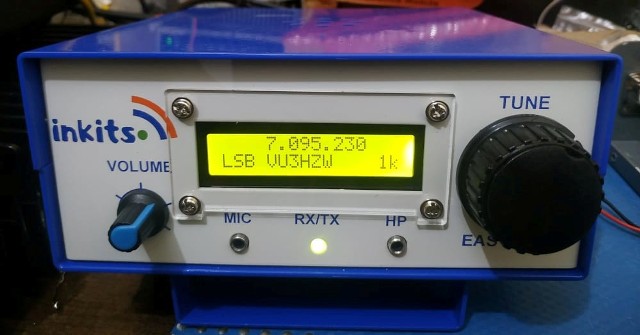Wide-Band Transformers In the Bitx Mixer Continued
In the previous web page, we looked at the difference that the number of turns made at the input of the mixer transformer winding. Lets change the viewpoint and look at the input to the diode bridge.
We are going to look differentially. That is, across the 2 points rather than from 1 point to ground. The scope will be connected like this using 2 scope probes. This takes a special differential amplifier plug in.
First, lets look at the 4 turn, 5.25uH transformer input signal that we left off with in the previous page.
The left picture is the signal at the collector of Q7. The right picture is at the input to the diodes after going through the input transformer. The difference in amplitude is due to using a differential input to the scope instead of going from 1 end of the transformer to ground, we are going across the + and - leads of the transformer so we get twice the amplitude. There's not much change going through the transformer.
Lets look at a 13 turn, binocular, 69uH transformer again. Once again, the left picture is the collector of Q7 and the right picture is across the transformer leads going to the input of the mixer. The input to the diodes looks very similar to the 4 turn waveform above. The corners may be a little sharper but there appears to be no major difference. The waveform inversion is caused by the scope probes being hooked up reversed on the transformer leads. If I would have noticed it initially, I would have reversed them and the the waveform would look exactly like the one above.
What conclusion can we draw from all this? What I see is that as I've been told by many people, unless you are trying to match impedances where you have a turns ratio rather than a 1-1 ratio, the number of transformer turns really isn't particularly critical. The minimum amount of turns should be selected to give an inductive reactance of at least 4x the circuit impedance. In this particular application using FT37-43 cores or something with like characteristics, anywhere between 4-13 turns seems to work very similarly.
Lets look at one more thing while we are here. Lets move the scope probes to the output side of the mixer. The left picture is with no signal input. The spikes you see are from the vfo. Also notice the amplitude setting is 50mv/division. This is a double balanced mixer so both the vfo and the input signal should be attenuated. In this case, there is no input signal. The right picture shows an input signal at 14.2mhZ. The amplitude is now at 100mv/division. What we see is the combination of all the new frequencies created and the 2 original frequencies attenuated. If you look closely you can see a repeating signal that is spaced 1 division apart. That is the 10mhZ IF frequency that is used in the original Farhan design and implemented in the Far Circuits boards and the Version 3 boards. It gives us a waveform spaced every 100ns apart. In the bitx20a kit, it would be spaced every 91nsec apart as the kit has an 11mhZ IF.
By now you should just about be a mixer expert and probably wonder if you really need to know all of this "stuff". That you will have to answer for yourself.



.jpg)

No comments:
Post a Comment